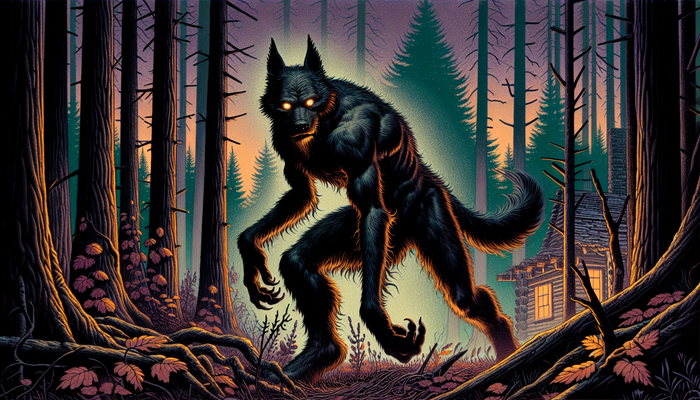Tennessee Wildman: Bigfoot Sightings in the Volunteer State

By Jack Sullivan, Cryptozoologist
In the realm of cryptozoology and unexplained phenomena, few creatures have captured the human imagination quite like Bigfoot. This elusive, ape-like being, said to roam the forests of North America, has been the subject of countless stories, investigations, and debates. While reports of Bigfoot sightings span the continent, one state in particular has emerged as a hotbed of activity: Tennessee. Known as the Volunteer State, Tennessee boasts a rich history of paranormal occurrences and bizarre encounters, with the legendary "Tennessee Wildman" at the forefront.
As a dedicated Bigfoot researcher, I have long been fascinated by the sheer volume and diversity of sightings reported in Tennessee. From the misty peaks of the Appalachian Mountains to the dense forests of the Cumberland Plateau, the state seems to be a magnet for this mysterious creature. Join me as we delve into the intriguing world of Bigfoot sightings in Tennessee, exploring the landscape of encounters, examining notable cases, and considering the implications for our understanding of this enduring mystery.
The Landscape of Bigfoot Sightings in Tennessee
Tennessee's varied geography and extensive wilderness areas provide an ideal habitat for a creature as elusive as Bigfoot. Sightings have been reported across the state, with concentrations in several key regions:
- In the east, the Appalachian Mountains, which run along Tennessee's border with North Carolina, have long been associated with tales of the "Tennessee Wildman." These ancient, mist-shrouded peaks are home to vast tracts of undisturbed forest, offering ample cover for a large, undiscovered primate.
- To the west, the Mississippi River Valley, with its dense bottomland hardwood forests and sprawling wetlands, has also produced its share of Bigfoot encounters. The river's tributaries, such as the Wolf River in the Memphis area, have been the scene of numerous sightings over the years, with locals reporting glimpses of a large, hairy creature lurking in the shadows of the forest.
- However, it is the central portion of the state that has emerged as the true epicenter of Bigfoot activity in Tennessee. The Smoky Mountains, straddling the Tennessee-North Carolina border, are a rugged wilderness of deep valleys, towering peaks, and old-growth forests. This area, along with the nearby Cumberland Plateau and the expansive forests of Middle Tennessee, accounts for the majority of the state's Bigfoot sightings.
According to the Bigfoot Field Researchers Organization (BFRO), a leading group dedicated to investigating and documenting Bigfoot encounters, Tennessee ranks among the top ten states in the nation for credible sightings. With over 100 reported incidents on record, the Volunteer State has earned a reputation as a prime location for those seeking evidence of this elusive creature's existence.
Notable Bigfoot Encounters in Tennessee
Among the many Bigfoot sightings reported in Tennessee, several stand out for their level of detail, the credibility of the witnesses, and the lasting impact they have had on the public perception of the creature.
Cannon County Encounter
One such encounter occurred in 1992 in Cannon County, located in the heart of Middle Tennessee. Darrell Denton, who would later serve as the mayor of Ridgetop, Tennessee, was hunting on his grandfather's property when he came face-to-face with an eight-foot-tall, black-furred creature. Denton, who had previously been skeptical of Bigfoot's existence, described the creature as having "black eyes and gritted teeth." The encounter was brief but intense, with the creature letting out a roar that echoed through the surrounding woods before disappearing into the forest.
Denton's experience left him shaken and convinced of the reality of Bigfoot. He avoided the woods for years afterward, a testament to the profound impact the sighting had on him. His transformation from skeptic to believer is a common thread among many who claim to have encountered the creature firsthand.
Duck River Encounters
The Duck River, which winds its way through Middle Tennessee, has also been the site of several notable Bigfoot encounters:
- In the late 1970s, a man in Columbia, Tennessee, reported a sighting along the river's banks. He and a friend were hiking when they suddenly encountered a large, hairy, bipedal creature just 20 yards away. The creature let out a "growling scream" before vanishing into the dense foliage, leaving the witnesses stunned and shaken.
- More recently, in 2009, a couple camping along the Duck River in Hickman County had a chilling experience in the middle of the night. They were awakened by a "loud, deep, howl" that seemed to silence all other wildlife in the area. The sound, which lasted for several seconds, was unlike anything they had heard before, and they were convinced it was the call of a Bigfoot.
Appalachian Region Encounters
The Appalachian region of Tennessee, particularly the areas bordering North Carolina, has also produced its share of compelling Bigfoot encounters. In 2017, John Bruner, the head of the Bigfoot 911 research group, claimed to have had a face-to-face encounter with a nearly 9-foot-tall creature near Lake James in McDowell County, North Carolina, just across the state line from Tennessee.
Bruner, who works as a medical examiner, has a unique perspective on the lack of physical evidence for Bigfoot's existence. He believes that the creatures are intelligent enough to dispose of their dead, much like humans, which would explain the absence of remains. While this theory is controversial, it highlights the ongoing debate surrounding the nature and origins of Bigfoot.
Regional Variations and Unique Characteristics
One of the most intriguing aspects of Bigfoot sightings in Tennessee is the diversity of descriptions and characteristics attributed to the creature. While the classic image of Bigfoot is that of a towering, bipedal, ape-like being covered in shaggy, dark fur, witnesses in different parts of the state have reported encounters with creatures that deviate from this norm.
Flintville Monster
In the Flintville area of Tennessee, locals have described a particularly aggressive and foul-smelling variant of Bigfoot known as the "Flintville Monster." This creature is said to stand around 7 feet tall and emit a strong, skunk-like odor. Its behavior is reportedly more hostile than that of the typical Bigfoot, with some witnesses claiming it has charged at them or displayed threatening postures.
White Screamer
In the town of White Bluff, located in Dickson County, residents have spoken of the "White Screamer," a banshee-like entity that is said to emit blood-curdling shrieks. While not strictly a Bigfoot in the traditional sense, the White Screamer is often associated with the broader realm of cryptozoology and is considered by some to be a variant or relative of the Bigfoot phenomenon.
Old Green Eyes
The Lookout Mountain area, which straddles the Tennessee-Georgia border, has its own unique twist on the Bigfoot legend. Here, witnesses have reported encounters with "Old Green Eyes," a Bigfoot-like creature distinguished by its glowing, emerald-hued eyes. This feature sets it apart from the typical description of Bigfoot and has led some researchers to speculate about the possibility of bioluminescence or other unusual adaptations.
Screaming Jacks
In the Cumberland Plateau region of Tennessee, a variant known as the "Screaming Jacks" has been reported. These creatures are said to emit powerful, primal screams that echo through the rugged landscape. Some witnesses have described the sound as a cross between a human scream and a wild animal's roar, adding to the eerie and unsettling nature of the encounters.
The diversity of Bigfoot descriptions in Tennessee has led some researchers to propose that the state may be home to multiple subspecies or regional variations of the creature. The idea of Tennessee as a "melting pot" for Bigfoot populations has gained traction in recent years, with some suggesting that the state's varied habitats and extensive wilderness areas could support distinct groups of creatures with their own unique characteristics and behaviors.
Bigfoot-Related Phenomena in Tennessee
Beyond the direct sightings of Bigfoot-like creatures, Tennessee has also been the site of various phenomena that some researchers believe may be related to the presence of these elusive beings. These occurrences, while not conclusive proof of Bigfoot's existence, add to the intrigue and mystery surrounding the legend.
Massive Footprint Trails
In the Cosby area of Tennessee, located in the foothills of the Great Smoky Mountains, witnesses have reported finding massive, 1,000-yard-long trails of enormous footprints. These tracks, which are said to dwarf those of any known animal, have been interpreted by some as evidence of Bigfoot's presence in the region. The sheer size and length of the trackways have led to speculation about the creature's weight, stride, and movement patterns.
Complex Structures
Also in the Cosby area, researchers have discovered large, complex structures made from intertwined branches and trees. These constructions, which can be up to 20 feet in diameter, have been dubbed "nests" or "shelters" by some in the Bigfoot community. While their purpose remains unclear, some believe they could serve as temporary dwellings or resting places for the creatures.
Unusual Behaviors
In the Chattanooga region and along the Tennessee-Georgia border, witnesses have reported unusual behaviors exhibited by Bigfoot-like creatures. These include the throwing of rocks and sticks, which some interpret as a form of communication or territorial display. In other cases, the creatures have been said to engage in apparent interactions with other animals, such as coyotes, leading to speculation about their social structure and interspecies relationships.
One particularly intriguing aspect of these Bigfoot-related phenomena is the possibility that they may hint at a level of intelligence or even supernatural abilities possessed by the creatures. The construction of complex structures, the use of tools (such as rocks), and the apparent communication with other animals all suggest a level of cognition and adaptability that goes beyond the typical view of Bigfoot as a simple, primitive beast.
While these phenomena are difficult to verify and are often met with skepticism from the scientific community, they continue to fuel the imaginations of Bigfoot enthusiasts and researchers alike. The idea that these creatures may possess advanced problem-solving skills, social behaviors, or even paranormal capabilities adds a new dimension to the ongoing quest to understand and explain the Bigfoot mystery.
Native American Folklore and Mythology
The legend of Bigfoot in Tennessee is not a modern invention; it has deep roots in the folklore and mythology of the region's indigenous peoples. For centuries, Native American tribes in the area have told stories of mysterious, human-like creatures that roam the forests and mountains, often imbuing them with spiritual or supernatural significance.
Tlanuwa
In the Chattanooga area, the Cherokee people have long spoken of the "Tlanuwa," a massive, cave-dwelling bird of prey that bears a striking resemblance to the modern conception of Bigfoot. According to legend, the Tlanuwa was large enough to carry off children and was greatly feared by the tribe. This creature shares similarities with other mythical beings from Native American folklore, such as the Thunderbird and the Mothman, which have been reported in nearby regions.
Tennessee Pygmies
In Middle Tennessee, there are stories of the "Tennessee Pygmies," a race of diminutive, humanoid creatures said to have been discovered by early European settlers. These beings, described as standing between two and three feet tall, were allegedly found living in underground caves and tunnels throughout the area. Some accounts claim that the remains of these creatures were unearthed in large numbers, with "acres-large slate-box graveyards" being discovered.
The Tennessee Pygmies bear a resemblance to the "Little People" of Native American folklore, who are said to inhabit the forests and mountains of the southeastern United States. Tribes such as the Cherokee, Choctaw, and Chickasaw all have stories of these small, mysterious beings, which are often described as having magical or supernatural powers.
The prevalence of Bigfoot-like creatures in the folklore of Tennessee's indigenous peoples has led some researchers to speculate about the origins and nature of these beings. One theory suggests that Bigfoot may be a living remnant of an ancient hominid species, such as Gigantopithecus or Paranthropus, that once inhabited the region. These creatures, which are thought to have gone extinct millions of years ago, may have survived in small, isolated populations, giving rise to the legends and stories that have been passed down through generations.
Another possibility is that the Bigfoot phenomenon is deeply intertwined with the spiritual and cultural beliefs of Native American tribes. The creatures may represent a link between the physical and spiritual worlds, serving as guardians, tricksters, or messengers from the realm of the supernatural. The enduring presence of Bigfoot in indigenous folklore suggests that the legend is not merely a product of modern fascination, but rather a reflection of a long-standing belief in the existence of mysterious, human-like beings that inhabit the wild places of the world.
Skepticism and the Search for Evidence
Despite the numerous eyewitness accounts and intriguing phenomena associated with Bigfoot in Tennessee, the creature's existence remains unproven from a scientific standpoint. Skeptics argue that the lack of conclusive physical evidence, such as remains, DNA samples, or clear photographs, casts doubt on the reality of Bigfoot.
One of the primary challenges in verifying Bigfoot's existence is the difficulty in obtaining tangible, empirical evidence. While footprints, hair samples, and other trace evidence have been collected over the years, none have been definitively linked to an unknown primate species. Skeptics contend that much of this evidence could be the result of misidentification, hoaxes, or natural phenomena.
The absence of a Bigfoot carcass or skeleton is another point of contention. Critics argue that if these creatures truly exist, there should be a body or remains discovered at some point, given the number of alleged sightings and the creature's supposed size. The fact that no such specimen has been found, despite decades of searching, is seen by some as a strong argument against Bigfoot's existence.
However, proponents of Bigfoot's reality offer counterarguments to these skeptical positions. Some, like John Bruner, the medical examiner who claimed to have encountered a Bigfoot in North Carolina, believe that the creatures are intelligent enough to dispose of their dead, much like humans. This behavior, they argue, could explain the lack of physical remains.
Others point to the vast, remote wilderness areas of Tennessee and other parts of the country, noting that the discovery of a Bigfoot carcass would be a rare event, given the creature's presumed low population density and elusive nature. They also argue that the absence of evidence is not necessarily evidence of absence and that the lack of a body does not disprove Bigfoot's existence.
The ongoing debate surrounding Bigfoot's reality has led to a dedicated community of researchers and enthusiasts who continue to investigate sightings, collect evidence, and explore the possibilities. Groups like the Bigfoot Field Researchers Organization (
From Bigfoot to UFOs: Hangar 1 Publishing Has You Covered!
Explore Untold Stories: Venture into the world of UFOs, cryptids, Bigfoot, and beyond. Every story is a journey into the extraordinary.
Immersive Book Technology: Experience real videos, sights, and sounds within our books. Its not just reading; its an adventure.



























